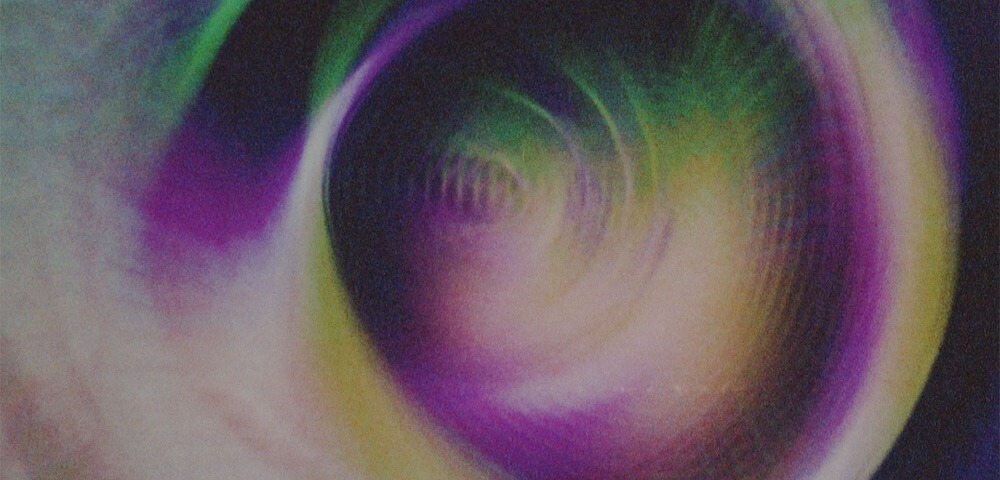
THURSDAY, SEPTEMBER 29 – 7:30 PM
ONE NIGHT ONLY!
This fall, Spectacle is pleased to host artist, filmmaker and writer Lydia Nsiah for a special one-night evening of selected films touching on spiraling body archives, techno distortions and the getting by forgetting – followed by a Q+A with the artist moderated by filmmaker Melissa Friedling.
distortion
2016. 5 mins.
Interference signals on all tracks: booming, choppy sound. The image disintegrates into digital blocks, into patterns and grids; flickers and vibrates. Flashing in between is a figure, a landscape, and a face. An uncanny rush of image and sound that probes the aesthetic potential of digitally deformed film. The concrete disintegrates into the abstract — distorted film in its most beautiful form.
to forget
2019. 17 min.
to forget is a filmic journey on the potentialities of forgetting and its resemblance to remembering. Recorded entirely on expired Super-8 and 16mm film, forgetting becomes productive and ‘visible’ in non-existing, fading and colour transformed film exposures. This (non-)documentation of possibly empty and fading spaces (to be) is further highlighted by Jejuno’s trance-like and uncanny sound composition: The abyss is present.
vs
2021. 8 min.
Images of buildings, strange architectural structures, in between vegetation and lots of blue sky: at first glance, it could be travel photos that Lydia Nsiah uses in the film vs. But the viewers’ eyes never arrive at the point of sorting out or more closely analyzing what they see: the images are accelerated, shifted, distorted, and blurred through a spiral rotation.
The artist designed and operated the technical apparatus for this. Recordings from server farms and data centers, which are the result of various translation processes between World Wide Web, expired 16mm films, and digital video, are sent into a metaphorical and literal maelstrom – becoming a mechanical eye that looks back and looks at us, the viewers. In return we look briefly into the abyss of the resource consumption that the server farms require to store millions and millions of bits and pixels.
Hui Ye’s composition processes the analogue and digital sounds of the multiple film recordings. A soundscape of layers and samples arises, which makes the film three-dimensional. The movement of the images, the spiral camera pan, is thus located between repetition and standstill, and becomes a seemingly eerie “impossibility.”
Like in earlier works, also in vs, Lydia Nsiah is concerned with recording and forgetting. What might a “body archive” (Julietta Singh) located in the sensorial look like? Who or what do data storage systems exclude? Can gaps be intentionally included in an archive? The strudel of images, the hypnotic sound of vs set the viewer’s entire body, not only the eye, in upheaval, in rapture, which deprives the subject of an ontological base. Arising through this “queering” of an established cinematographic human-machine connection is the possibility of a new, different way of dealing with memory, production of meaning, and ultimately cinema.
LYDIA NSIAH is an artist, filmmaker and writer, working with the in-between, abysses and gaps in audiovisual knowledge production by transforming and incorporating found and recorded analogue and digital memory images, often in collaboration with sound artists. She publishes and exhibits internationally on Virtuality, Forgetting and Remembering, Failure and Error, Decolonial Practice, Film Art and Use. Her works were shown, among others, at the Berlinale Forum Expanded, the Internationale Kurzfilmtage Oberhausen (DE), Prismatic Grounds/ Maysles Documentary Center, NYC (US), Crossroads San Francisco Cinemateque/ SFMOMA (US), IDFA – International Documentary Film Festival Amsterdam (NL), Festival Ecrã (BR), Bangkok Art & Cultural Center (TH), Blickle Kino/ Belvedere 21, Kunsthalle Krems (AT), Slovenska kinoteka (SL), Curtocircuíto, Santiago de Compostela (ES), Antimatter [Media Art], Victoria, BC (CA), Kunstforeningen GL Strand (DK). Her films are distributed by Arsenal – Institut für Film- und Videokunst and sixpackfilm. Her art is in the collections of Wien Museum, Van Abbemuseum, Center for Book Arts, Mumok, Belvedere, Calouste Gulbenkian Foundation, University of Applied Arts Vienna et al.
